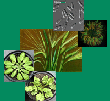| Seyoum, Y; Fetene, M; Strobl, S; Beck, E: Foliage dynamics, leaf traits, and growth of coexisting evergreen and deciduous trees in a tropical montane forest in Ethiopia., Trees Structure & Function, 26, 1495-1512 (2012), doi:10.1007/s00468-012-0723-6 | |
| Abstract: Foliage dynamics of three functional tree types representing major components of the tropical montane evergreen forest in southern part of Central Ethiopia were compared. The species were Podocarpus falcatus (evergreen gymnosperm), Prunus africana (evergreen broadleaf), and Croton macrostachyus (facultative deciduous). The hypothesis examined is that in such tropical trees, endogenous control of foliage dynamics by the leaf life-spans (LLS) is largely dominant over external signals. Crown foliage turnover, leafiness of twigs, LLS, photosynthetic performance, respiration rate, specific leaf area, and relative growth rates of the stems were investigated. Foliage dynamics and leafiness of the twigs were monitored over 2 years while leaf traits were followed over 3 months. The degree of inter and intra-individual synchronization of foliage phenophases was examined to get an estimate of the contributions of endogenous and external signals to the dynamics of the foliages. Autoregression analysis indicated significant influence of the moisture regime on leaf sprouting of Croton and Podocarpus. During pronounced dry periods, new leaves were not developed. Analysis of phenological data using circular statistics revealed that in spite of strong inter-individual synchronization of leaf flush and fall (Podocarpus and Croton), the dynamics of individual parts of the crowns were less synchronized. LLS was independent of climate factors and it had substantial contribution to the control of foliage turnover. Moreover, examination of ecophysiological traits of developing leaves of the studied functional types showed differing patterns with LLS corroborating the ecophysiological characteristics. Although overlaid by fungal infestation, both the foliage and ecophysiological properties of Prunus resemble that of Podocarpus but the former exhibited a shorter LLS and slightly higher metabolic rates. Nevertheless, all species reacted positively to high moisture with respect to stem growth. In spite of largely differing weather conditions of the 2 years, direct competitive advantage of one of the species over the others could not be detected. |

